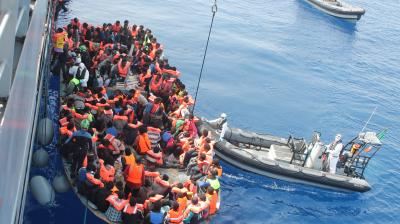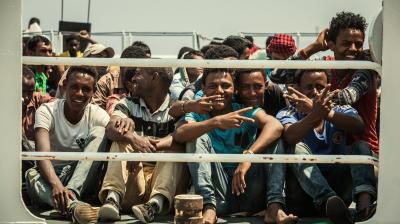State of play in the debate on migration management in Europe
This commentary is part of a series of four on ‘European migration management – lessons learned’.
Introduction
Domestic political demands dictate the manoeuvrability of European leaders in discussions on migration matters. Consequently, domestic concerns and uncertainties resonate in debates at EU level. To illustrate this, tensions at the June European Council increased to the point where Giuseppe Conte, Prime Minister of Italy, refused to endorse any text adopted at the summit unless other European Union (EU) member states promised support in dealing with the arrival of migrants in Italy. At the same time, Angela Merkel was put under domestic pressure to reach a European agreement to prevent a national political crisis. At the conference on Security and Migration organised by the Austrian Presidency focusing on cooperation with third countries, frustrations ran high, leading to an outburst between far-right leader and Italian interior minister Salvini and Luxembourg’s foreign minister Asselborn when Salvini expressed his views on African migrants coming to Europe and ‘keeping Italy for Italians’. These examples show that the migration debate is highly polarised and influenced by emotions and fears relating to national security, limiting discussions on solidarity-based considerations. How did we get here? And what are the consequences for future discussions on migration at EU level?
Background
The year 2015-2016 sparked discussion on a new European strategy on migration. The sudden increase in the influx of mixed migration showed that the European policy framework, including the Common European Asylum System (CEAS), was not built to cope with a sudden arrival of high numbers of refugees, asylum-seekers and migrants in the EU. In the field of migration and asylum, decisions of one member state have a direct effect on the situation of other member states. This was illustrated by Merkel’s “wir schaffen das” and the subsequent lockdown of the Western Balkan Route. Hence, a reform of the European migration policy and legislative framework was inevitable. In order to assist Greece and Italy with the rise in asylum applications, the European Council adopted an Emergency Relocation Scheme, a temporary derogation from the Dublin Regulation, to move asylum-seekers that were eligible to participate in the procedure from Italy and Greece to other member states. The Visegrád countries (Hungary, Poland, Slovakia and the Czech Republic) opposed this system that was based on mandatory reallocation quotas, but were outvoted through the Qualified Majority Voting (QMV) procedure. This enhanced the dissatisfied voice of the Visegrád members and sharpened the divide in the EU. Due to differing interests of member states, the EU was not able to obtain consensus on necessary reforms and no structural actions were undertaken regarding European internal migration management.
Meanwhile, new policy proposals focused mainly on enhanced external border management, outsourcing eligibility procedures and addressing the root causes of migration based on cooperation with countries of transit and countries of origin, effectively dodging substantive discussions on responsibility-sharing in the EU.
A recent example of the outsourcing and externalisation of the processing of asylum claims is the proposal by the interior ministers of Austria and Italy to hold asylum-seekers (including refugees) on board ships after they have been rescued to process their asylum claims on the ship, based on eligibility and admissibility. Needless to say, this proposal was not well received by African countries and NGOs.
Rise of right-wing populism in the EU?
The lack of an effective European response to the mixed-migration flows paved the way for right-wing populist parties to gain traction across the EU. The rise of right-wing populist parties is linked to the national public perception on the migration theme. Recent election outcomes show that the Visegrád countries are no longer the only countries taking a conservative stance in the migration debate: Orbán has found support from other European countries. Remarkably, in the Mediterranean region nationalism and Euroscepticism are also on the rise, as illustrated by the established Italian government (Lega Nord, Five Star Movement). The same goes for Scandinavia, where conservative and right-wing parties are on the rise in Norway (Conservative Party, Progress Party), Finland (Finns Party) and Sweden (Sweden Democrats). An increasing number of countries consider their national concerns more important than the establishment of a solid CEAS. As a consequence, security considerations play a dominant role in the migration debate as illustrated by the re-establishment of border controls within the Schengen area and the aim of reinforcing European external border controls to stop irregular migration.
"In order to better manage mixed migration flows, European policymakers have agreed on a comprehensive approach towards migration built upon five pillars. However, implementation of the five pillars remains a struggle."
The European debate on migration management
In order to better manage mixed migration flows, European policymakers have agreed on a comprehensive approach towards migration built upon five pillars: addressing the root causes of migration; expanding opportunities for legal migration and mobility; decreasing irregular migration by fighting human trafficking and migrant smuggling; establishing an effective CEAS and the implementation of swift return procedures for those who are not legally residing in the EU. The comprehensive approach implies that all policy elements are interlinked and need to be implemented coherently to make the system work as a whole. However, implementation of the five pillars remains a struggle. Regarding the CEAS, discussions on how to allocate asylum applicants across EU member states is a sensitive issue. This aspect is governed by the Dublin Regulation, containing the hierarchy of criteria determining the member state responsible for assessing an asylum claim. In practice, this boils down to the state of first arrival (Italy, Greece or Spain), resulting in an unbalanced system of migration management in the EU. Because of this, frontline member states on the EU’s southern external border are calling for solidarity-based responsibility-sharing. At the same time, the Visegrád countries have made clear that they will not accept any mandatory reallocation quota. The V4 would not participate in reallocation mechanisms based on voluntary contributions either. In the meantime, Germany wants to focus on preventing secondary movements within the EU, another aspect regulated by the Dublin Regulation.
The absence of agreement between member states on how to establish an effective, solidarity-based asylum system in the EU militates in favour of externalisation of asylum policies, making the EU dependent on the cooperation of third countries and adequate participation of member states in resettlement procedures. This is a fragile position, as it puts the EU’s credibility towards third countries on the line. To illustrate this, the UNHCR Emergency Transit Mechanism exemplified the importance of member state participation: due to a lack of sufficient resettlement pledges by European member states, resettlement procedures did not run in parallel with the arrival of evacuated refugees from Libya to Niger. Again, the bottleneck involved the dispute on how to allocate asylum-seekers, including refugees, across the EU. In the meantime, the administrative burden on Niger increased to the point that reception of additional asylum-seekers appeared no longer possible.
"The polarisation of the migration debate at national level has affected dynamics at EU level."
Since there is no strategy on how to cope effectively with asylum applicants in the EU over the long term, there is no political scope to open up and expand opportunities for regular migration pathways. Countries of origin, having been promised credible legal pathways to the EU for their nationals, are consequently less inclined to cooperate on the sensitive matter of the return of their country nationals. This shows that internal aspects of European migration management are easily linked to the external aspects of European migration management (cooperation with third countries on development and return) and influence each other.
"Instead of focusing increasingly on external aspects of migration, the EU should focus on how agreement can be reached on the CEAS, by depolarising the debate and taking a pragmatic, solidarity-based stance."
Conclusion
The polarisation of the migration debate at national level has affected dynamics at EU level. As long as no consensus is achieved between these fronts within the EU, tensions between member states will increase and a deeply rooted divide in the Council remains. Without agreement on the CEAS, the Schengen system remains under pressure, putting the fundamental principle of free movement under strain. Instead of focusing increasingly on external aspects of migration, the EU and its member states should focus on how agreement can be reached on the CEAS (including radical reform of the Dublin Regulation and the establishment of a workable system of responsibility-sharing in the EU), by depolarising the debate and taking a pragmatic, solidarity-based stance on the matter. It is only then that the migration management system based on a comprehensive approach will work.






